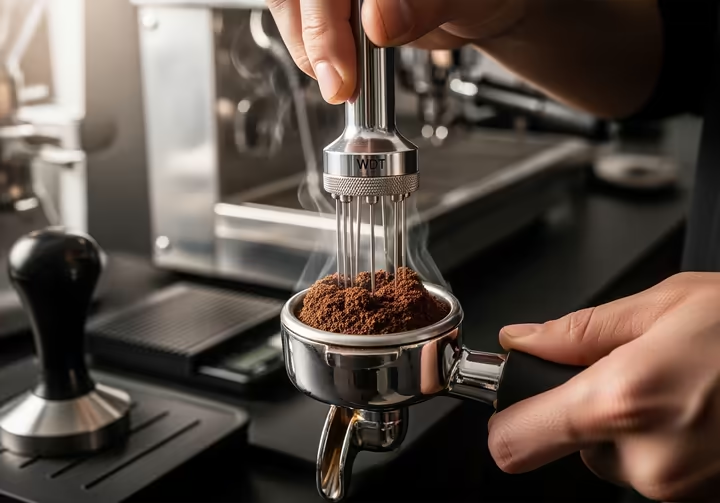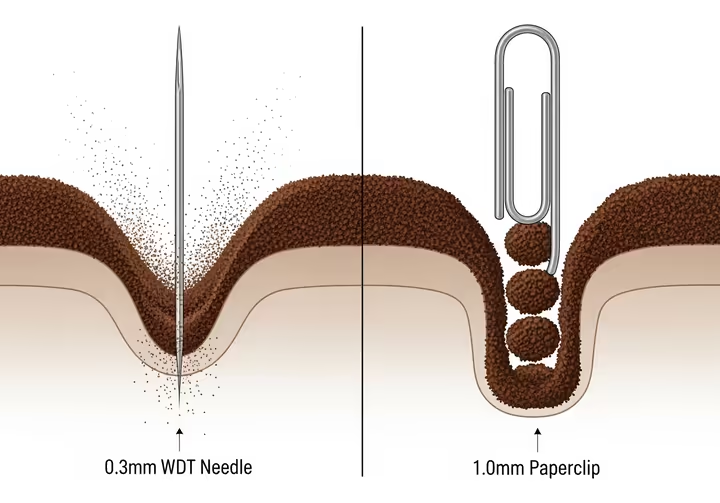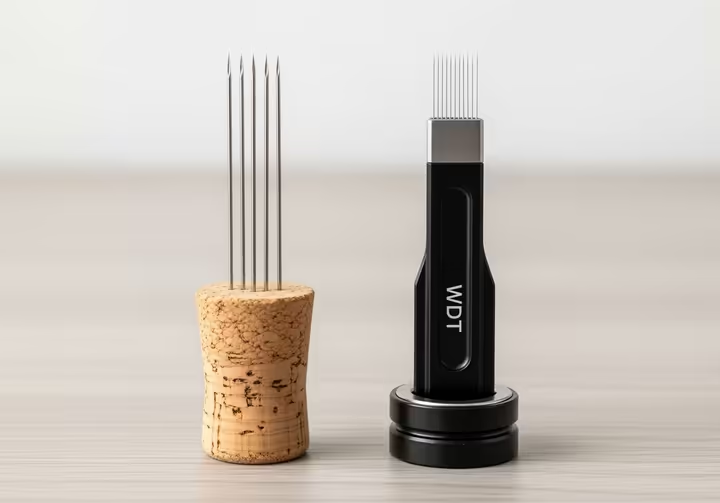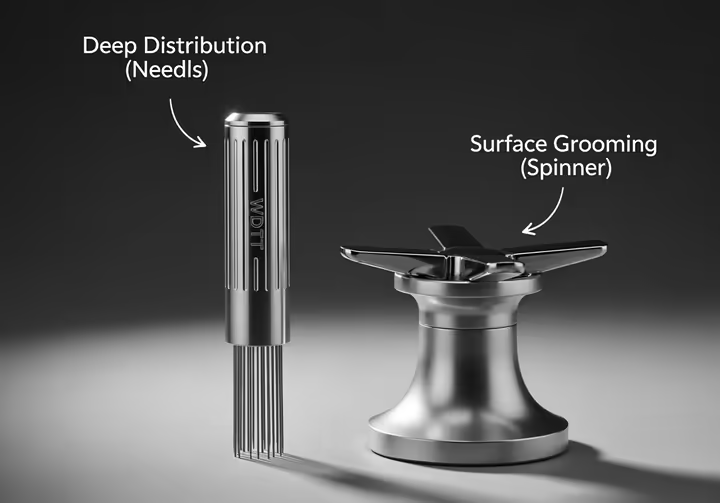A Guide to WDT for Espresso
So you've got a fancy espresso machine, but your coffee still tastes... meh. The culprit might be tiny clumps in your coffee grounds. This guide explains a surprisingly simple fix, the Weiss Distribution Technique, or WDT for short.

The Problem in the Puck
Why your coffee grounds are a mess
Freshly ground coffee isn't a neat, uniform pile. It's a messy landscape of hills and valleys, full of clumps, static, and dense spots. Clumps form because of coffee oils (especially in dark roasts), heat from the grinder, and humidity. 1 Grinding also creates static, making fine particles stick together like tiny magnets. 1 The result is a mound of grounds with dense clumps and airy pockets all mixed up.
Hello, Channeling
This mess leads to the #1 enemy of good espresso, channeling. An espresso machine shoves hot water through the coffee at high pressure. Water is lazy, it always takes the easiest path through the grounds. 4
It can’t push through the dense clumps, so it bypasses them and jets through the weaker, less dense areas instead. 7 These weak spots become tiny water highways, so water flows through parts of the coffee instead of the whole thing. This is channeling.

What channeling looks and tastes like
Using a bottomless portafilter? You'll see the disaster happen in real-time. Look for thin, fast-flowing blond streams, sputtering jets of espresso, and gaps in the flow of coffee. 5 Even the spent coffee puck will have cracks or pinholes, proving the water didn't flow through it evenly. 5
The result is a truly disappointing coffee. Channeling creates a muddled brew that is both over, and under, extracted at the same time. The water rushing through channels over, extracts those grounds, making them bitter and harsh. 4 Meanwhile, the dense clumps the water missed are under, extracted, adding sour, undeveloped flavors. 9
The Weiss Distribution Technique
A simple fix is born
In the early 2000s, home espresso fans were getting serious. Tools like the bottomless portafilter were showing just how common channeling was. 13 But home grinders back then were notorious for making clumpy, uneven grounds, which made a good shot hard to pull. 14
Enter John Weiss. He wasn't a coffee pro, just a home brewer with a PhD in biochemistry who was frustrated by his own channeling issues. 13 His frustration led to a major breakthrough in making espresso. He noticed that just leveling the top of the coffee wasn't working because the problem went deeper.
The solution wasn't high-tech. Weiss grabbed a dissection needle from his college days and started stirring the grounds to break up clumps. 13 To stop the now-fluffy coffee from spilling, he used a cut-down yogurt cup as a makeshift funnel. 13 This was a game-changer because it fixed the real problem, deep inside the coffee, not just the stuff on top.

Weiss shared his discovery on coffee forums online in 2005. 13 At first, people were skeptical. Most were focused on leveling the surface, so stirring the whole thing seemed weird. But the logic was good and the results were easy to see, so other home baristas started trying it and spreading the word. 13 Today, the WDT is a standard part of making high-quality espresso, used by home brewers and even World Barista Championship competitors. 15
How It Works (The Science Bit)
WDT does more than just break up clumps. The fine needles fluff up the grounds, separating sticky particles and adding air to create a uniform, airy bed of coffee. 19 This creates a medium of even density, not just on the surface, but through the entire puck. 18
This fluffy bed of coffee changes how water flows through it. A WDT-prepped puck provides even resistance everywhere. 22 This forces the brew water to soak the entire puck evenly instead of finding easy channels to rush through. 6, 15
The end result? A balanced extraction of all the tasty stuff from the coffee, like sugars and oils. 19 This means a higher extraction yield, so more flavor ends up in your cup. 24 For you, this means a much better tasting shot, one that's balanced, sweet, and complex instead of sour and bitter. 20
What Makes a Good WDT Tool
Needle Size Matters
The tool you use really matters. The most important part is the needle diameter. Experience has shown that ultra-thin needles, between 0.25mm and 0.4mm, work best. 24 This is the sweet spot, thin enough to separate grounds but stiff enough not to bend.
Why so thin? It's physics. Thicker things like paperclips or toothpicks just push the coffee around like tiny plows. 29 They create new clumps and channels instead of fixing them. 31 A proper thin needle, however, slices between the grounds, gently separating them to create that fluffy state.

Material, Tips, and Handles
Needle material and tip shape also matter. Food-grade stainless steel is standard for being durable and safe. 24 The needles often come from acupuncture or 3D printer cleaning kits, which both use very fine, strong steel. 35
Looped tips are bad, they tend to drag and catch grounds. 29 Sharp or smoothly rounded tips are ideal, as they pass through the coffee with the least disruption. 29 And don't worry, sharp needles are unlikely to scratch a quality steel filter basket if you use proper technique. 29
The handle and needle layout are important too. A good handle made of aluminum, wood, or polymer gives you better control. 39 The needles should be arranged to cover the whole basket, often with a slight outward splay. 41 If they're too close together, they'll just act like one big clump-pusher. 43
How to Do It: The WDT Method
Using a WDT tool is a gentle process, not a violent stir-a-thon. Start by grinding your coffee into the portafilter. You'll want a dosing funnel, a simple ring that sits on your basket to prevent spills. 44, 29 A funnel lets you be more thorough without making a mess. 29
Funnel on? Time to stir. The goal is to gently rake and fluff the grounds to break up clumps and equalize density. Start by putting the needles deep into the coffee, all the way to the bottom of the basket. 29

Move the tool in small circles or crisscross patterns while slowly lifting it up through the coffee. 29 This gradual ascent is key, as it makes sure every layer of coffee gets de-clumped and fluffed up. Your coffee should now look perfectly level and fluffy. 44 As an optional last step, give the portafilter a single, firm vertical tap on the counter to settle the grounds and collapse any big air pockets. 6
Common Mistakes
It's easy, but you can still mess it up. Don't be too aggressive with the stirring, you'll just compact the grounds again. Make sure you reach the very bottom of the basket, or you'll leave a dense layer that's guaranteed to cause channeling. 23
Don't over-stir either, as that can cause the tiniest particles (fines) to sink to the bottom and clog the filter. 28 Finally, using a tool with needles that are too thick is a classic mistake that just makes things worse.
DIY vs. Store-Bought Tools
Okay, you're sold on WDT. Now what tool do you get? You can go the DIY route or buy a commercial tool. The classic DIY method is simple, just stick some thin acupuncture needles into a wine cork. 15 This is super cheap, customizable, and works perfectly well. 48
Lately, lots of commercial WDT tools have popped up, from 3D-printed models to fancy ones made of aluminum and wood. 15 They offer better ergonomics, clever designs like retractable needles, and nice stands to keep your coffee station tidy. 15 Plus, they can look really cool.

So, are the fancy ones worth the extra cash? Functionally, a well-made DIY tool can work just as well as an expensive one. 51 Buying a commercial tool isn't really about better taste, it's an investment in a nicer workflow, a better feel, and aesthetics. 52 If you're a beginner, the DIY route is a great place to start. If you value design and convenience, a commercial tool can be a satisfying upgrade.
Not Just for Espresso
WDT for Pour-Over
WDT started with espresso, but the idea works for other brewing methods too, like pour-over. For pour-over, the enemy isn't high-pressure channeling, but uneven saturation of the coffee grounds. The WDT concept has proven very useful for brewers like the Hario V60. 55
For pour-over, you can use it on dry or wet grounds. The biggest impact comes during the "bloom," the first pour of water. A gentle stir with a WDT tool after adding water ensures all the coffee gets evenly wet. 55

This prevents dry clumps from forming, helps release trapped CO2 gas evenly, and creates a flat bed for the rest of your pours. 57 This initial step pays off for the rest of the brew, leading to a more consistent drawdown and a cleaner, more balanced cup of coffee. This shows WDT is a fundamental improvement to coffee brewing, not just a fix for espresso.
Needles vs. Spinners
People often confuse WDT needle tools with the "spinning" kind, like wedge or spirographic distributors. A WDT tool uses thin needles to stir deep inside the coffee grounds. 23 A spinning distributor has a solid base that sits on top of the portafilter, you rotate it to groom the surface of the coffee. 60 They're both sold as distribution tools, but they do very different things.

The key difference is what they actually do, WDT works deep, spinners just work on the surface. WDT is a volumetric technique that fixes density issues throughout the entire puck . 18 Spinning tools are surface groomers, they only affect the top few millimeters of coffee. 60 They create a pretty, polished surface, but do nothing to fix the clumps and density problems underneath.
This can be worse than doing nothing at all. Using a spinner on clumpy coffee doesn't fix the problem, it just hides it under a nice-looking surface. The pressure from the spinner can even create a hidden layer of compacted coffee just below the surface. 62 This can make channeling even more likely. 64
These tools are not interchangeable. The WDT tool must always be used first . It is the only one that performs true, deep distribution to fix the core problem. A spinning tool can then be used, if you want, to create a perfectly flat surface for tamping. 59 The spinner is a final grooming step, not a primary distribution tool.
Works cited
- How to prevent clumping when grinding coffee - Perfect Daily Grind, https://perfectdailygrind.com/2023/03/how-to-prevent-clumping-when-grinding-coffee/
- Puck Preparation For Perfect Espresso - Bunafr, https://bunafr.com/puck-preparation-for-perfect-espresso/
- Reasons for Espresso Shot Variation, Inconsistencies, and Imperfection, https://espressooutlet.com/blogs/news/reasons-for-espresso-shot-variation-inconsistencies-and-imperfections
- Espresso pucks — and why they matter - Timemore, https://www.timemore.com/blogs/read-our-blog/espresso-pucks-and-why-they-matter
- How To Prevent Espresso Channeling & Achieve The Perfect Espresso Extraction, https://bigcupofcoffee.com/how-to-prevent-espresso-channeling/
- What is WDT? How to Effectively Distribute Coffee for Even Extraction - Newton Espresso, https://newtonespresso.co.nz/en-us/blogs/blog/wdt
- espressooutlet.com, https://espressooutlet.com/blogs/blog-articles/how-to-fix-channeling-in-espresso-extraction-a-comprehensive-guide#:~:text=Channeling%20occurs%20when%20water%20finds,or%20otherwise%20unbalanced%20espresso%20shots.
- How to Fix Channeling in Espresso Extraction: A Comprehensive Guide, https://espressooutlet.com/blogs/blog-articles/how-to-fix-channeling-in-espresso-extraction-a-comprehensive-guide
- Understanding Channeling in Espresso: Causes, Effects, and ..., https://www.triplebarcoffee.com/blog/what-is-channeling-in-espresso/
- Espresso Channeling - What Is It? – Clive Coffee, https://clivecoffee.com/blogs/learn/what-is-channeling
- How to Fix Espresso Extractions: Timing, Taste & More - YouTube, https://www.youtube.com/watch?v=30F1nIF1-v8
- How does channeling influence the taste of espresso? - Reddit, https://www.reddit.com/r/espresso/comments/lua8e4/how_does_channeling_influence_the_taste_of/
- What is WDT in Espresso? We Talked to Its Creator, John Weiss, https://dailycoffeenews.com/2022/12/14/what-is-wdt-in-espresso-we-talked-to-its-creator-john-weiss/
- perfectdailygrind.com, https://perfectdailygrind.com/2023/01/what-is-the-weiss-distribution-technique/#:~:text=Most%20WDT%20tools%20have%20around,enthusiasts%20have%20adopted%20the%20technique.
- Weiss Distribution Technique - A Guide to WDT Tools - Cafe Fabrique, https://cafefabrique.com/blogs/infos/wdt-tool
- dailycoffeenews.com, https://dailycoffeenews.com/2022/12/14/what-is-wdt-in-espresso-we-talked-to-its-creator-john-weiss/#:~:text=WDT%20stands%20for%20Weiss%20Distribution,extending%20from%20a%20handheld%20piece.
- How to make an (almost) free DIY Weiss Distribution Technique (WDT) tool! - GreenestBean, https://greenestbean.com/guides/how-to-make-almost-free-diy-wdt-tool/
- What is the Weiss Distribution Technique & should you use it before tamping coffee?, https://perfectdailygrind.com/2023/01/what-is-the-weiss-distribution-technique/
- Do You Really Need WDT? - Clive Coffee, https://clivecoffee.com/blogs/learn/do-you-really-need-wdt
- WDT (Weiss Distribution Technique) vs. Blind Shakers: Their Differences and Impact on Espresso Extraction, https://espressooutlet.com/blogs/news/wdt-weiss-distribution-technique-vs-blind-shakers-their-differences-and-impact-on-espresso-extraction
- Why you need the espresso wdt tool and how to choose the right one? - IKAPE, https://ikapestore.com/blogs/guides/why-you-need-the-espresso-wdt-tool
- Mastering the Art of Espresso: A Deep Dive into the Weiss Distribution Technique (WDT) - Central Coast Coffee, https://www.centralcoastcoffee.com.au/blogs/coffee-news/mastering-the-art-of-espresso-a-deep-dive-into-the-weiss-distribution-technique-wdt
- Weiss Distribution Technique - Barista Hustle, https://www.baristahustle.com/weiss-distribution-technique/
- Espresso WDT Tool: The Ultimate Guide to Perfect Coffee..., https://www.espressobasket.com/blog/espresso-wdt-tool-the-ultimate-guide-to-perfect-coffee-distribution
- I pulled 90 shots to test WDT's impact on extraction/flow... : r/espresso - Reddit, https://www.reddit.com/r/espresso/comments/12lejmz/i_pulled_90_shots_to_test_wdts_impact_on/
- Nutation Mutation - Barista Hustle, https://www.baristahustle.com/nutation-mutation/
- What is channeling and how does it affect espresso extraction? - Perfect Daily Grind, https://perfectdailygrind.com/2022/03/what-is-channeling-espresso-extraction/
- Why Use a WDT Tool? A Beginner's Guide to Even Espresso Extraction - IKAPE, https://ikapestore.com/blogs/guides/why-use-espresso-wdt-tool
- An In-Depth Look At WDT Tools - introvert, https://introvertmakes.com/pages/in-depth-look-at-wdt-tools
- Is my WDT too thick? (0.4mm according to manufacturer) : r/espresso - Reddit, https://www.reddit.com/r/espresso/comments/seraj6/is_my_wdt_too_thick_04mm_according_to_manufacturer/
- WDT Tool - SWORKSDESIGN, https://sworksdesign.com/WDT-Tool-p387817741
- WDT (Weiss Distribution Technique) for Espresso - What Is It, Why & Ho - HiBREW, https://www.hibrew.com/blogs/brew-guides/wdt-weiss-distribution-technique-guide
- Newbie here, am I using this WDT tool correctly? Results feel weird : r/espresso - Reddit, https://www.reddit.com/r/espresso/comments/1hthpab/newbie_here_am_i_using_this_wdt_tool_correctly/
- WDT Tool_0.35mm * 8 Polished Needles for Espresso Distribution_Easily Clip... | eBay, https://www.ebay.com/itm/297397761471
- WDT Needles | Acupuncture Needles | Nozzle Cleaning Needles | Needles - Etsy, https://www.etsy.com/listing/1184727367/wdt-needles-acupuncture-needles-nozzle
- Accupuncture needles – General discussion, announcements and releases - Prusa3D Forum, https://forum.prusa3d.com/forum/original-prusa-i3-mk3s-mk3-general-discussion-announcements-and-releases/accupuncture-needles/
- 0.30 mm Acupuncture Needles for 3D Printing from patshead.com on Tindie, https://www.tindie.com/products/patshead/030-mm-acupuncture-needles-for-3d-printing/
- WDT Tool - looped ends vs pointed ends - which is better? : r/espresso - Reddit, https://www.reddit.com/r/espresso/comments/s7nv3r/wdt_tool_looped_ends_vs_pointed_ends_which_is/
- Best WDT Tool for Espresso in 2025 - Subminimal, https://subminimal.com/blogs/news/best-wdt-tool-espresso
- WDT tool showdown: Sworksdesign, BPlus and Londinium with a short review of each : r/espresso - Reddit, https://www.reddit.com/r/espresso/comments/wb0xmf/wdt_tool_showdown_sworksdesign_bplus_and/
- PSA: Your WDT tool matters - espresso - Reddit, https://www.reddit.com/r/espresso/comments/safdoh/psa_your_wdt_tool_matters/
- IKAPE Coffee Rotary WDT V3 Unboxing/Review | How to adjust the needle height | Upgrading my WDT Tool - YouTube, https://www.youtube.com/watch?v=rUoKedf_e0E
- Why Your WDT Tool Fails? Fix Needle Density in 1 Minute! - neouza, https://neouza.com/blogs/coffee-tool-knowledge/why-your-wdt-tool-fails-fix-needle-density-in-1-minute
- Weiss Distribution Technique - CoffeeGeek, https://coffeegeek.com/guides/howtos/weiss-distribution-technique-wdt-how-to/
- WDT needs dosing funnel : r/espresso - Reddit, https://www.reddit.com/r/espresso/comments/126wstw/wdt_needs_dosing_funnel/
- Espresso Tips - How To Pick The Right Dosing Funnel | #Shorts - YouTube, https://www.youtube.com/shorts/6x17vkd_Jns
- How to Use a WDT Tool for Espresso (Like a Pro) - Frothy Fusion, https://frothyfusion.com/how-to-use-a-wdt-tool-for-espresso/
- Home made WDT #barista #coffee #espresso #goldenbrowncoffee #cafe #wdt - YouTube, https://m.youtube.com/watch?v=BXnWNFB3Mfk
- Homemade WDT Tool - YouTube, https://m.youtube.com/shorts/7_V7JyNE1m4
- WDT tool, DIY (Do it yourself) - YouTube, https://www.youtube.com/shorts/7hFlPJKdOPM
- Does a WDT tool truly make a difference? : r/espresso - Reddit, https://www.reddit.com/r/espresso/comments/11a6zil/does_a_wdt_tool_truly_make_a_difference/
- WDT Tools – Manual vs Rotary: Pros & Cons – Hypergrind Coffee, https://hypergrindcoffee.com/blogs/coffee-corner/wdt-tools-manual-vs-rotary-pros-cons
- Best WDT Distribution Tools: Complete Coffee Accessories Buying Guide - Barista Life, https://baristalife.co/blogs/blog/wdt-tool-buying-guide
- Are WDT Tools Worth It for Espresso? - Brewedco, https://www.brewedcocoffee.com/blogs/the-coffee-bar/are-wdt-tools-worth-it-for-espresso
- Have you heard of the WDT? – Talking Crow Coffee Roasters, LLC, https://talkingcrowcoffeeroasters.com/blogs/informed/have-you-heard-of-the-wdt
- How to brew with Pulsar (coming from V60) - Pocket Science Coffee, https://pocketsciencecoffee.com/2023/10/01/how-to-brew-on-pulsar-coming-from-v60/
- Wet Weiss Distribution - Barista Hustle, https://www.baristahustle.com/wet-weiss-distribution/
- ADVANCED HOOPING - Scott Rao, https://www.scottrao.com/blog/2024/12/13/advanced-hooping
- Coffee Distribution Tools: Which One Makes the Biggest Difference?, https://coffeemachinetools.com/coffee-distribution-tools-which-one-makes-the-biggest-difference/
- What is WDT? | Newton Espresso, https://newtonespresso.co.nz/blogs/blog/what-is-wdt
- A Comparison of Distribution Tools - Prima Coffee Equipment, https://prima-coffee.com/blog/a-comparison-of-distribution-tools/
- To Spin or Not to Spin: The Role of Tamper Rotation in Espresso Extraction, https://espressooutlet.com/blogs/blog-articles/to-spin-or-not-to-spin-the-role-of-tamper-rotation-in-espresso-extraction
- Distributor vs Tamper : r/espresso - Reddit, https://www.reddit.com/r/espresso/comments/h9r3b5/distributor_vs_tamper/
- WDT with wedge distribution or tamp or all three? : r/espresso - Reddit, https://www.reddit.com/r/espresso/comments/siihht/wdt_with_wedge_distribution_or_tamp_or_all_three/
- How important are wdt and distribution tools? : r/espresso - Reddit, https://www.reddit.com/r/espresso/comments/1793f38/how_important_are_wdt_and_distribution_tools/